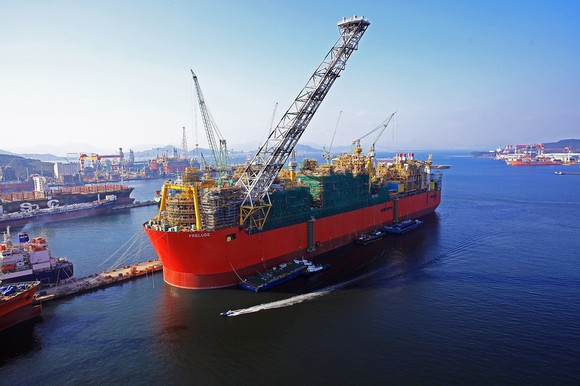Even though oil prices went through a rough patch in the fourth quarter, you might not be able to tell by looking at Royal Dutch Shell's (NYSE: RDS-A) (NYSE: RDS-B) most recent earnings report. The company's earnings were up 48% compared to this time last year -- 137% on a current cost of supplies basis, which is similar to American fair value accounting standards -- even though the price of a barrel of oil this past quarter was relatively close to prices from the same period in 2017.
Let's take a look at what Shell did so well in the most recent quarter to produce such strong results in the face of a lower commodity price environment.

Image source: Royal Dutch Shell.
By the numbers
| Metric | Q4 2018 | Q3 2018 | Q4 2017 |
|---|---|---|---|
| Revenue | $104.6 billion | $100.5 billion | $88.1 billion |
| Net income | $5.59 billion | $5.84 billion | $3.81 billion |
| Earnings per ADS | $1.36 | $1.40 | $0.91 |
| Operating cash flow | $22.0 billion | $12.09 billion | $7.28 billion |
DATA SOURCE: ROYAL DUTCH SHELL EARNINGS RELEASE. ADS = AMERICAN DEPOSITARY SHARES.
So that line about it being a lower commodity price environment was a little bit of a fib. Yes, the company's oil price realizations were down 12.1% compared to the third quarter, to $59.89 per barrel. The difference was that its realized gas prices went through the roof to $5.75 per thousand cubic feet. That's the highest gas price Shell has had since 2014.
Unsurprisingly, this meant that its integrated gas business was one of the two shining stars of the quarter. The other part of the business that performed spectacularly this past quarter was its oil products business, mostly driven by its oil trading segment.
The other thing worth pointing out is that incredible surge in operating cash flow this past quarter. A large portion of that was from a significant drawdown in working capital, which happens from time to time at Shell because it has several billion dollars tied up in working capital at any given time. Excluding changes in working capital, operating cash flow was still an impressive $12.9 billion.

Data source: Royal Dutch Shell. Chart by author.
The highlights
- Total production for the quarter came in at 3.79 million barrels of oil equivalent per day. That was pretty much flat compared to this time last year. For the year, the company produced 3.67 million barrels of oil equivalent per day, the same as 2017's results. It's worth noting, though, that the company divested several upstream production assets over the past couple of years.
- Shell completed its $30 billion divestment program in the fourth quarter by unloading $2.4 billion worth of assets from its holdings in New Zealand, Ireland, and Norway.
- Compared to prior quarters, this one was light on project start-ups. The one start-up in the quarter was its Clair phase II platform in the North Sea. Also, just after the end of the quarter in January, the company announced that the expansion of its Geismar petrochemical facility in Texas was complete.
- Shell is slowly getting more and more into the renewable energy business. This past quarter it acquired offshore wind leases in the Northeast U.S. that, if completed, would generate 4.1 Gigawatts of power.
- The company also announced its third wave of share buybacks. This third tranche of buybacks gives management authority to repurchase $2.5 billion worth of shares, and is part of a larger plan to buy back $25 billion worth of stock between now and 2020.
What management had to say
One of the remarkable aspects of this recent turnaround has been Shell's disciplined capital allocation approach. While CFO Jessica Uhl didn't put any specific numbers on its spending plans, she did highlight the company's priorities and how they will dictate spending in 2019 and beyond.
Our priorities remain the same and we remain disciplined with our cash allocation. Reducing our net debt remains our first priority and divestment proceeds help achieve this. We want to continue to strengthen our balance sheet with AA equivalent credit metrics. Then with our cash flow from our operations, we will fund our capital program, our dividend payments, and interest expense. Surplus cash will be used to fund our buyback program and reduce debt further, which is what we have been doing. These priorities are unchanged, and our actions have fully adhered to this framework, with the reduction in debt, the removal of the scrip, continued investment driving cash flow growth, and the start of the share buyback program.
Getting stronger by the day
When current CEO Ben VanBeurden took the helm, his mission from the get-go was to prioritize improving Shell's rates of return and to make the company more shareholder-friendly. This most recent earnings report will probably be one of the things written about his tenure. Shell's big bets on liquefied natural gas (LNG) are already paying off in a big way, and the company's ability to cut billions out of its expenses and become profitable at much lower oil prices is a great sign for its future.
For those investors concerned about where oil prices will go in the coming quarters, earnings results like these should assure them that Shell will be able to generate steady returns in almost all price environments. With shares trading at 12 times earnings and a dividend yield of 6.3%, Shell's stock looks pretty attractive.

